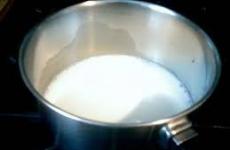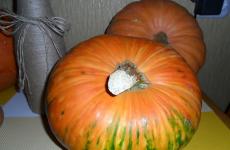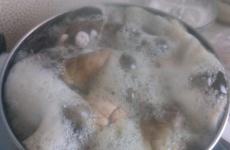The shoot is one of the main organs of the plant. Shoot types
From the germinal bud, the first shoot of the plant is formed - its main shoot, or first order escape.
From the main shoot are formed side shoots, or second order shoots, and when branching is repeated - of the third order, etc.
Adventitious shoots are formed from adnexal buds.
This is how the system of shoots is formed, represented by the main shoot and side shoots of the second and subsequent orders. Escape system increases total area contact of the plant with the air.
Depending on the function performed, shoots are distinguished as vegetative, vegetative-generative and generative. Vegetative (unmodified) shoots, consisting of a stem, leaves and buds, and vegetative-generative (partially modified), additionally consisting of a flower or inflorescence, perform the functions of air nutrition and provide the synthesis of organic and inorganic substances. In generative (completely modified) shoots, photosynthesis most often does not occur, but sporangia are formed there, the task of which is to ensure the reproduction of the plant (a flower also belongs to such shoots).
The shoot that produces flowers is called flowering shoot, or peduncle(sometimes the term "peduncle" is understood in a narrower sense - as a section of the stem, on which the flowers are located).
Main escape organs
A vegetative unmodified shoot is a single plant organ, consisting of a stem, leaves and buds, formed from a common array of meristems (the cone of growth of the shoot) and having a single conducting system. The stems and leaves, which are the main structural elements of the shoot, are often considered as its constituent organs, that is, organs of the second order. In addition, the obligatory affiliation of the escape is the kidneys. The main external feature that distinguishes the shoot from the root is the presence of leaves.
Monopodial branching
Monopodial branching is the next stage in the evolution of shoot branching. In plants with a monopodial type of shoot structure, the apical bud is preserved throughout the life of the shoot. The monopodial type of branching is often found among gymnosperms, it is also found in many angiosperms (for example, in many species of palms, as well as plants from the Orchid family - gastrochilus, phalaenopsis and others). Some of them have a single vegetative shoot (for example, Phalaenopsis is pleasant).
monopodial plants- the term most often used in the description of plants of tropical and subtropical flora, as well as in popular science literature on indoor and greenhouse floriculture.
Monopodial plants can vary significantly in appearance. Among them there are rosette, with an elongated shoot, bushy.
Sympodial branching
In plants with a sympodial type of shoot structure, the apical bud, having completed development, dies off or gives rise to generative run away. After flowering, this shoot no longer grows, and a new one begins to develop at its base. The structure of the shoot in plants with a sympodial type of branching is more complicated than in plants with; sympodial branching is an evolutionarily more advanced type of branching. The word "simpoidal" is derived from the Greek. sym("together" or "many") and pod("leg").
Sympodial branching is characteristic of many angiosperms: e.g. for limes, willows and many orchids.
In orchids, in addition to the apical ones, some sympodial orchids also form lateral inflorescences, developing from buds located at the base of the shoot (Pafinia comb). The part of the shoot pressed against the substrate is called the rhizome. It is located, as a rule, horizontally and does not have true leaves, only scaly. A reduced, almost indistinguishable rhizome occurs in many Masdevallia, Dendrobiums and Oncidiums; well distinguishable and thickened - in cattleyas and lelias, elongated - in bulbophyllums and cologins, reaching 10 or more centimeters. The vertical part of the shoot is often thickened, forming the so-called tuberidium, or pseudobulb. Pseudobulbs can be of various shapes - from almost spherical to cylindrical, cone-shaped, club-shaped and elongated, resembling reed stalks. Pseudobulbs are storage organs.
sympodial plants- the term most often used in the description of plants of tropical and subtropical flora, as well as in popular science literature on indoor and greenhouse floriculture.
|
Bulbophyllum grandiflorum |
Cirrhopetalum macraei. Curtis "s botanical magazine vol. 127 ser. 3 nr. 57 tab. 7787, 1901 |
Oncidium dasystyle. Curtis "s botanical magazine vol. 127 ser. 3 nr. 57 tab. 7787, 1901 |
Dendrobium senile. Curtis "s botanical magazine vol. 127 ser. 3 nr. 57 tab. 7787, 1901 |
Evolution of branch types
Shoot modifications (metamorphosis)
The shoot is the most variable in appearance organ of the plant. This is due not only to the general multifunctionality of vegetative organs that arose in the process of evolution, but also to the changes that occur in the process of plant ontogenesis, due to adaptation to a variety of conditions. environment, and at cultivated plants- under human influence.
The main type of shoot of a green plant is an above-ground (aerial) assimilating shoot, bearing green leaves of the middle formation on the axis. However, assimilating shoots are not the same. Often, along with the main function of photosynthesis, these shoots also have others: the deposition of reserves and the supporting function (mostly in perennial stems), vegetative reproduction (creeping shoots, lashes).
Modification of underground shoots
Shoots living underground, under the influence of a complex of conditions that are sharply different from the terrestrial environment, almost completely lost the functions of photosynthesis and acquired other equally important vital functions, such as organs for transferring an unfavorable period, storage nutrients, vegetative renewal and reproduction of plants. Modified underground shoots include: rhizome, caudex, underground stolon and tuber, bulb, corm.
caudex- a perennial organ of shoot origin of perennial grasses and semi-shrubs with a well-developed taproot that persists throughout the life of the plant. Together with the root, it serves as a place of deposition of reserve substances and bears many renewal buds, some of which may be dormant. There are many caudex plants among the umbrella plants (femur, ferula), legumes (alfalfa, lupins), composites (dandelion, wormwood, rough cornflower).
underground stolon- an annual elongated thin underground shoot with underdeveloped scaly leaves. At the thickened ends of the stolons, plants can accumulate reserve substances, forming tubers or bulbs (potatoes, stolons, adoxas).
stem tuber- a modified shoot with a pronounced storage function of the stem, the presence of scaly leaves that quickly peel off, and buds that form in the axils of the leaves and are called eyes (potato, Jerusalem artichoke).
Bulb- underground (rarely above-ground) highly shortened specialized shoot, in which reserve substances are deposited in scales of leafy nature, and the stem is transformed into the bottom. The bulb is a typical organ of vegetative renewal and reproduction. Bulbs are characteristic of monocotyledonous plants from the Lily family (lily, tulip, onion), Amaryllis (amaryllis, narcissus, hyacinth), etc. As an exception, they are also found in dicotyledonous plants - in some species of sour and butterwort.
Corm- a modified underground shortened shoot with a thick stem storing assimilants, adventitious roots growing from the underside of the corm, and preserved dried leaf bases (membraneous scales), which together form a protective cover. Corms have saffron, gladiolus, colchicum.
Modifications of above-ground shoots
Unusual lifestyle and/or adaptations to special conditions the existence of plants lead to various modifications of shoots. At the same time, shoots can serve not only to store nutrients, reproduce and reproduce plants, but also perform other functions. There are frequent cases when not the entire shoot is modified, but only its leaves, and some of their metamorphoses are outwardly and functionally similar to shoot metamorphoses (thorns, antennae).
thorn- strongly lignified leafless shortened shoot with a sharp tip. Spines of shoot origin perform mainly a protective function. At the wild apple tree, wild pear, laxative buckthorn ( Rhamnus cathartica) shortened shoots turn into spines, having limited growth and ending in a point. In honey locust ( Gleditschia triacanthos) powerful branched spines are formed on the trunks of dormant buds. Many species of hawthorn have spines that form from axillary leaf buds, which topographically corresponds to lateral shoots.
Claudius- a modified lateral shoot with the ability to grow long, with green flat long stems that act as a leaf. As an organ of photosynthesis, the cladodium has a well-developed chlorophyll-bearing tissue located under the epidermis. Plants with cladodias include Mühlenbeckia flatiflora ( Muhlenbekia platyclada), Decembrist cactus ( Zygocactus truncates), southern carmichelia ( Carmichaelia australis), collection ( Colletia cruciata) and prickly pear ( Opuntia).
Phyllocladius- a modified leaf-like flattened lateral shoot with limited growth and performing the functions of a leaf. Phyllocladia develop from lateral buds, so they are always found in the axil of a small membranous or scaly leaf. Performing the function of photosynthesis, the shoots of phylloclades also outwardly acquire a resemblance to a leaf, which manifests itself in limited growth and complete loss of the metameric structure. The phenomenon of phylloclady is characteristic of such plants as the needle, swept away, species of the asparagus genera ( Asparagus), phyllanthus ( Phyllanhtus). Phyllocladia are found not only in angiosperms, but also in some gymnosperms, in particular, in coniferous plant from the family Nogoplodnikovye - phyllocladus.
Notes
Literature
- Korovkin O. A. Anatomy and morphology higher plants: glossary of terms. - M: Bustard, 2007. - 272 p. - ISBN 978-5-358-01214-1
- Nukhimovsky E. L. Fundamentals of biomorphology of seed plants: Habitus and forms of growth in the organization of biomorphs. - M: Overlay, 2002. - T. 2. - 859 p. - 750 copies. - ISBN 5-85493-067-6
- Botany with the basics of phytocenology: Anatomy and morphology of plants: Proc. for universities / Serebryakova T. I. and others. - M: ICC "Akademkniga", 2007. - S. 341-365. - 2,000 copies. - ISBN 978-5-94628-237-6
- Timonin A.K. Botany: in 4 volumes - M: Publishing Center "Academy", 2007. - T. 3. - S. 52-69. - 3,000 copies. - ISBN 978-5-7695-3184-2
- Botany. Textbook for universities: in 4 volumes. T. 1. Cell biology. Anatomy. Morphology. Based on the textbook by E. Strasburger / Ed. A. K. Timonina, V. V. Chuba. - M: Publishing Center "Academy", 2007. - T. 1. - S. 261-266. - 3,000 copies. - ISBN 978-5-7695-2744-9
- Lotova L. I. Botany: Morphology and anatomy of higher plants: Textbook. - M: KomKniga, 2007. - S. 312-321. - 1,500 copies. - ISBN 978-5-484-00698-4
- Barabanov E.I., Zaichikova S.G. Botany: textbook. for stud. universities. - M: Publishing Center "Academy", 2006. - S. 82-85. - 3,000 copies. - ISBN 5-7695-2656-4
- Yakovlev G. P., Chelombitko V. A. Botany: textbook. for stud. universities. - St. Petersburg: Spetslit, publishing house SPHFA, 2003. - S. 129-132. - 5,000 copies. - ISBN 5-299-00237-8
- Andreeva I. I., Rodman L. S. Botany. - M: KolosS, 2005. - S. 172-175. - 3,000 copies. - ISBN 5-9532-0114-1
- Tropical and subtropical plants. Collections of the Main Botanical Garden of the USSR Academy of Sciences (Cactaceae-Compositae). Moscow: Nauka, 1976.
- Smirnova E.S. Morphology of orchid shoot systems. - M.: Nauka, 1990

- This is a vegetative organ of a plant, usually located above the soil surface and on which buds, leaves, flowers are located. Slightly thickened places on the stem where leaves are attached are called knots, and the distances between nodes are internodes.
Lateral kidneys sitting at the base of the leaves are called axillary. Shoots according to the characteristics of their growth and position in space can be little or strongly branched, upright, creeping, creeping, climbing, curly. Creeping shoots, unlike creeping ones, not only lie on the surface of the soil, but also take root with adventitious roots formed from stem nodes. Climbing plants, as a rule, have thin or wriggling shoots, sometimes leafless at the ends (antennae), or various attachments, suckers, etc., with which they cling to other inanimate objects.
According to the intensity of growth of internodes and their length, the shoots are divided into elongated and shortened. Elongated shoots are sometimes called growth shoots, they main function is the development of living space. Shortened shoots can bear flowers or, like rosette forms of plants, form a group of leaves pressed to the soil.
According to the structure and life span of shoots, plants are herbaceous and woody. Herbaceous plants are represented by annual, biennial and perennial herbs. Woody plants form trees, shrubs, shrubs.
Branching of shoots is associated with the formation of lateral shoots from axillary buds.
Pinching of the apical bud: An example of a change in shoot growth is an increase in the development of side shoots as a result of the removal of the apical bud.
Shoots may change. In many plants, underground shoots are formed in the soil, in which reserve nutrients are accumulated. These substances are necessary to survive unfavorable conditions for growth. These are organs of vegetative reproduction.
rhizomes- This is an underground shoot that looks like a root. The rhizome bears scale-like leaves, in the axils of which are axillary buds. Adventitious roots are formed on the rhizome, and lateral branches of the rhizome and above-ground shoots develop from the axillary buds. Rhizomes are found in perennials. herbaceous plants(horsetail, fern, cereals, etc.). Rhizomes live from several to 15-20 years.
Tuber- this is a thickened underground shoot. The tuber has axillary buds - eyes.
Bulb- underground shortened modified shoot. The stem of the bulb forms the bottom. Leaves, or scales, are attached to the bottom. The outer scales are usually dry. They perform a protective function, cover the juicy scales, in which nutrients and water are deposited. At the bottom there is an apical bud, from which aerial leaves and a flower-bearing arrow develop. Adventitious roots develop on the lower part of the donut. Bulbs are typical for perennials(lilies, tulips, onions, garlic, etc.).
stolons- these are underground shoots, at the end of which tubers, bulbs, rosette shoots develop. The stolon lives only one year.
The modifications of the shoot also include thorns (wild apple tree, wild pear), antennae (pumpkin, grapes), whips (bone, tenacious), above-ground stolons (whiskers) - strawberries, cactus stems.
Fill out an application for preparation for the exam in biology or chemistry
The escape- This is the part of the plant, consisting of a stem and leaves and buds located on it. Instead of leaves or together with them, flowers or inflorescences may develop on the shoot.
In the process of evolution, shoots arose when plants began to grow on land. That is, shoots are characteristic of all living higher plants. At lower plants, which are algae, there are no shoots, since their entire body is not differentiated into organs and is called a thallus (or thallus).
All shoots develop from buds. But the first shoot of the plant develops from the germinal bud. Such an escape is called the main one. The main escape is the first order escape. From the buds growing on it, shoots of the second order develop, on which shoots of the third order can grow, etc.
A branched shoot system helps the plant to capture more sunlight and the process of photosynthesis proceeds more efficiently in it. That is, the shoot system provides air nutrition to plants.
On the shoot stem, the buds are usually located at the nodes, and one bud is at the top of the shoot. The first are called axillary, and the second - apical. However, sometimes buds can grow on internodes, leaves, roots. it adnexal buds.
Axillary buds grow in leaf axils. But if the leaf has already fallen, then the bud is on the stem without a leaf, only the remaining leaf scar is visible under it.
On the stem of the shoot, the buds are arranged in the same way as the leaves. If the leaves are arranged alternately, then the buds (birch, hazel) will also be located. If the arrangement of the leaves is opposite, then there will be two buds in each node (lilac, elderberry).
The appearance of the kidneys and their location on the shoot are characteristic features which can be used to identify the type of plant.
The buds of almost all plants are covered on the outside with modified leaves - kidney scales. Their function is to protect the internal parts of the kidney from mechanical damage and drying out. However, there are plants (for example, buckthorn) whose buds do not have scales. Such kidneys are called naked.
What is inside the kidney depends on its type. At vegetative buds there is a rudimentary stem with rudimentary leaves and rudimentary buds. In other words, the vegetative bud is a rudimentary vegetative shoot. Inside generative buds on the rudimentary stem there are rudimentary buds, rudimentary leaves may also be present. Generative buds are also called flower buds. Of these, a flowering shoot develops with a flower or inflorescence.
Typically, generative buds are somewhat larger than vegetative buds and rounder.
| Types of shoots | |||
| By function | On the development of internodes | ||
| Vegetative shoots | flowering shoots | shortened shoots | elongated shoots |
| Carry out air nutrition of plants. | Perform the function of reproduction. | Internodes almost do not grow. In herbaceous plants, the leaves sit very close, forming a rosette (primrose, plantain, saintpaulia, dandelion). In woody forms, such shoots often bear flowers and fruits. | With the development of the kidney, internodes develop rapidly. |
There are several types of stems.
upright many woody and herbaceous plants have stems (they usually have shoot growth directed upwards, towards the sun). They have a well-developed mechanical tissue, they can be lignified (birch, apple) or herbaceous (sunflower, corn).
Creeping stems creep along the ground and can take root at the nodes (creeping tenacious, strawberries).
curly the stems, rising up, wrap around the support (field bindweed, hops).
clinging the stems rise up, clinging to the support with antennae (mouse peas, grapes).
In the course of evolution, branching appeared in thallus (lower) plants; in these plants, the growth points simply bifurcate. Such a branch is called dichotomous, it is characteristic of pre-shoot forms - algae, lichens, liverworts and anthocerot mosses, as well as horsetail and fern outgrowths.
With the appearance of developed shoots and buds, monopodial branching, in which one apical bud retains its dominant position throughout the life of the plant. Such shoots are ordered, and the crowns are slender (cypress, spruce). But if the apical bud is damaged, this type of branching is not restored, and the tree loses its typical appearance(habit).
The most recent type of branching in time of occurrence - sympodial, in which any nearest bud can develop into an escape and replace the previous one. Trees and shrubs with this type of branching are easy to pruning, crown formation, and in a few years they are overgrown with new shoots without losing their habit (linden, apple, poplar).
A kind of sympodial branching false dichotomous, which is characteristic of shoots with an opposite arrangement of leaves and buds, therefore, instead of the previous shoot, two grow at once (lilac, maple, mock orange).
In most plants, the leaves depart from the nodes one by one, and the leaf arrangement is called next, alternate or spiral. If there are two leaves opposite each other on the node, the leaf arrangement is called opposite; at the same time, in the vast majority of cases, the leaves of two adjacent pairs depart in mutually perpendicular planes, so that the leaves of the upper pair do not obscure the lower one below it, and 4 orthostiches can be drawn on the stem, connecting the attachment points of leaves located one below the other (cross-opposite leaf arrangement, for example, in labiales, carnations, lilacs, in many norichnikovyh and other plants, Fig. 226, 1). If three or more leaves depart from the node, the leaf arrangement is called whorled (for example, in elodea, common juniper, oleander, crow's eye Paris quadrifolia, horsetail, etc.). In neighboring whorls, the leaves are also usually located not one above the other, but alternating, i.e., in the intervals between the leaves above and below the located whorls, so that twice as many orthosts can be drawn on the stem than the number of leaves in the whorl (Fig. 226, 2 ).
Leaf arrangement:
1 - opposite; 2 - whorled.
False whorls should be distinguished from real whorls of leaves, for example, in bedstraw, woodruff: they have opposite leaves, but their stipules are developed in the same way as leaves, and false whorls of 4-6-8-12 leaves are obtained.
At spiral leaf arrangement, the leaves of seed plants are not arranged randomly, but in a certain order, characteristic of each plant species. If we mentally connect with a line the points of attachment of the leaves located upwards directly one after the other, until we reach the leaf sitting above the one from which we started (i.e., on the same orthostiche), then we will get the so-called main or genetic1 spiral; the set of leaves in it, not counting the last one, which sits on the same orthostiche with the first one, is called a leaf cycle. The angle of the circle at which one sheet is separated from another, located above or below it, is called the angle of divergence (divergence2).
The stem is a vegetative organ of a plant that has negative geotropism (it grows in the opposite direction of the force of attraction), representing the axis of the shoot, carrying leaves, buds, and reproductive organs. Its main functions:
- Support - due to mechanical tissues (wood fibers in xylem) brings leaves to the light
- Conductive - thanks to conductive tissues - xylem (upward current) and phloem (downward current) - transports substances between the root and leaves
- Storage - in the center of the stem is the core, where the reserve plant nutrient - starch is stored
- Vegetative reproduction - here are possible different variants and methods, for example: cuttings, layering
- Photosynthesis - in some cases, the stems themselves photosynthesize (aloe, horsetail)
The escape
Remember the "formula"! Shoot = stem + leaves + buds. As can be seen from the formula, the shoot consists of a stem and leaves and buds located on it, the shoot itself develops from a bud or seed. Only adventitious roots can depart from the shoot. It grows upward due to the constant cell division by mitosis of the growth cone located at the top of the stem and protected by bud scaly leaves. In the cone of growth, all elements of the shoot are laid - the stem, leaves, inflorescences, buds, flowers. Lateral buds provide branching of the shoot. The stem grows in thickness due to phellogen and cambium.

The part of the stem on which the leaf or leaves is located is called the node. The distance between two adjacent nodes is an internode. Leaf axil - the area between the base of the leaf and the stem, in the leaf axil there is an axillary bud. In general, the shoot has a jointed (metameric) structure, metamere - each repeating node. Shoots in which the internodes are well defined, and the adjacent leaves are distant from each other, are called elongated. If the internodes on the shoot are almost absent, and the nodes are very close together, such shoots are called shortened.
The following stem structures are distinguished: primary and secondary.
- Primary - is formed as a result of the activity of the apical (apical) meristem
- Secondary - formed due to the activity of the cambium
In monocotyledonous plants, at the initial stages of shoot development, the primary structure of the stem is formed, which persists throughout life. In perennial dicotyledonous plants and gymnosperms, this structure undergoes a number of changes, so that the secondary structure gradually forms from the primary stem structure.

stem cut
The stems of different plants have different anatomical organization, but the structure of the stem of seed plants must be remembered. It is listed below.
A clear understanding of the location of tissues in the stem, as well as their function, should be built. The most superficially located are the integumentary tissues that protect the plant from adverse environmental factors: epidermis, cork, crust. Deeper lies the bast (phloem) - a conductive tissue through which a downward current of organic substances is carried out. Next comes a layer of cambium, an educational tissue, due to which the stem grows in thickness. Wood (xylem) lies even deeper - a conductive tissue that provides an upward current to the leaves of water and mineral salts.
In the intervals between the conductive tissues there is a parenchymal tissue - the core rays. In the thickness of the conductive tissues there are mechanical tissues that give support to the plant. Mechanical tissues are represented in the xylem by wood fibers, and in the phloem by sclerenchymal elements. In the center of the stem lies the core, which belongs to the group of basic plant tissues. The core is a storage tissue, starch, a reserve plant nutrient, is stored here.

As a result of the activity of cambial cells, secondary xylem and phloem are laid, and the stem gradually thickens. There is always more secondary xylem than secondary phloem. In the future, the primary cover (epiderm) is replaced by a cork formed by phellogen (cork cambium), which lays the phellem (or cork) outward, and the phelloderm (cork skin) inward. Let me remind you that the periderm is a collection of tissues: cork skin, cork and cork cambium.

The nature of the branching of the shoot
Occurs as the shoot grows. Branching of the shoot is necessary to increase the area of contact with the habitat. There are 4 types of branching:
- Dichotomous (forked) - two identical branches develop from the growth cone of the apical bud, that is, the growth cone is divided in two (in club mosses, multicellular algae, mosses).
- Monopodial - the shoot grows for a long time due to the apical bud. It is typical for gymnosperms - pines, spruces.
- Sympodial - the apical meristem (bud) functions for a certain period of time (season), after which it dies, and its function is taken over by the lateral bud, growth continues. Present in bird cherry.
- False dichotomous - the apical bud dies off, and two oppositely located lateral buds form two apical shoots. Lilac, horse chestnut.

The way the escape is located in space
According to the location in space, the escape can be:
- Upright - constantly growing up
- Ascendant - some part of the stem develops on the surface of the substrate, then grows upwards as an upright stem
- Creeping - grows horizontally, rooting at the nodes
- Creeping - grows horizontally, without rooting nodes
- Wrapping around a support - due to the poor development of mechanical tissues, the stem is forced to create additional support for itself
- Clinging to a support - the same situation as a twisting stem, but clinging to a support with the help of antennae
As the saying goes, it's better to see once than hear a hundred times.

Shoot modifications
Long-term evolution has led to the emergence of unique mechanisms for plant adaptation to environmental conditions, in particular, to the development of modified shoots. A modified shoot is necessary for a plant to perform important functions, such as: vegetative propagation, accumulation of nutrients, protection, attachment to the substrate.
Modified shoots are of two types: aboveground and underground. It is important to understand that wherever the shoot is located, it will satisfy the formula above: shoot = stem + leaves + buds. Don't forget it, it will come in very handy!
Let's move on to the classification of shoot modifications.

© Bellevich Yury Sergeevich 2018-2020
This article was written by Yury Sergeevich Bellevich and is his intellectual property. Copying, distribution (including by copying to other sites and resources on the Internet) or any other use of information and objects without the prior consent of the copyright holder is punishable by law. To obtain the materials of the article and permission to use them, please contact






